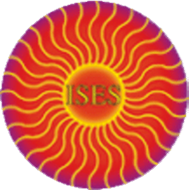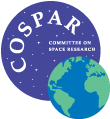
16-20 November, 2009 - Brugge, Belgium
| Session: | Poster Session 2 Space Weather Impacts on Communication Systems |
| Type: | Poster session |
| Date: | 18 November 2009 |
| Time: | 16:30 - 18:30 |
| Chair: | I. Stanislawska and D. Altadill |
| Co-chair: | |
| Remarks: |
| Seq | Time | Title | Abs No | ||||
| 1 | 00:00 |
Study on solar sources and their effects on ionosphere and geomagnetic field
PERRONE, LOREDANA1; Parisi, Mario2; MELONI, ANTONIO3; DAMASSO, MARIO2; GALLIANI, MARCO2; ZOLESI, BRUNO1 1ISTUTUTO NAZIONALE DI GEOFISICA E VULCANOLOGIA, ITALY; 2UNIVERSITA ROMA TRE, ITALY; 3INGV, ITALY The event of July 2004 occurred during cycle 23 is studied. We investigated the characteristics of this event and the properties of the correlated observations of ionospheric absorption, of the critical frequency of the ionospheric F2 layer and of geomagnetic activity at the ground level. Solar event is studied using the characteristics of CME and the temporal evolution of solar energetic particles in different energy ranges. We have tried to determine: possible clues that could allow a forecast evaluation of the effects produced at the Earth’s orbit by the interplanetary perturbations and as these effects are observed on the ionosphere and on the geomagnetic field, using some Antarctic observations. |
|||||
| 2 | 00:00 |
Main Improvements to Built a Real Time Prediction Tool for Hmf2
Blanch , Estefania; Altadill, David Ebro Observatory, SPAIN Recently, studies to determine the typical behaviour of the electron density peak height, hmF2, during geomagnetic storms have been performed. It has been identified that hmF2 increases systematically 1 to 3 hours after the onset of the main phase of the geomagnetic storm independently of the storm intensity (according Dst index). It shows an additional uplift in the nightime sector. The delay of this second uplift depends on the local time of the station at the onset of the main phase. This observed behaviour, which appears to be systematic, has been modelled empirically using Gaussian functions. The coefficients that define these functions depend on IMF configuration, local time and season. In this work we want to present the improvements made on the empirical model in order to adapt it to a near real time prediction tool for Space Weather purposes. Main changes have been done in the identification of the onset of the main phase of the storm. A variation in IMF Bz in three hours of 20 nT together with a IMF Bz ≤ -10 nT have been found to be the best choice to predict the occurrence of intense geomagnetic storms from IMF Bz data. Using this criterion, false alarms have been reduced significantly and the empirical model predicts the hmF2 uplift in near real time with an 86% of success converting this empirical model in an adequate forecasting tool. |
|||||
| 3 | 00:00 |
The use of macro modeling method for prediction of ionospheric influence on GPS station coordinates
Yankiv-Vitkovska, Liubov1; Swiatek, Anna2 1National University "Lviv Polytechnic", UKRAINE; 2Space Research Centre P.A.S., POLAND Temporal variations in permanent stations coordinates display effect of different phenomena, such as tectonic movement, ionospheric disturbances etc.
It is very important to use the information obtained during GPS station coordinates measurements. It opens new possibilities for technical means of measuring and throws fresh light on nature of physical influence on GPS observations. In addition to that, many phenomena that deal with satellite method of ground coordinates determination still do not have experimental explanation and quantitative theory. |
|||||
| 4 | 00:00 |
Space Weather Pecularities of the Total Electron Content Behavior and their Reflections in the Ionospheric Model
Maltseva, Olga; Nikitenko, Tatjana Institute for Physics, RUSSIAN FEDERATION
The total electron content TEC is an important ionospheric parameter for investigation of space weather influence on environment. An empirical model of TEC can be desirable to solve some problems of this investigation but such a model does not exist yet (Mendillo, 2006). To use the International Reference Ionosphere (IRI) model is seemed to be very attractive but it is not empirical for TEC unlike its main parameters foF2, NmF2, hmF2, M3000F2, Nh-profile. Model values of TEC are calculated as integral from Nh-profile hence it is necessary to compare them with experimental values. For this purpose the other determination can be used: TEC=NmF2*tau where tau is the effective ionospheric slab. |
|||||
| 5 | 00:00 |
Space weather impact on long-term trends in the ionosphere
Lastovicka, Jan Institute of Atmospheric Physics, ASCR, CZECH REPUBLIC Long-term changes (time scales longer than solar cycle) and trends in the ionosphere reflect increasing concentration of greenhouse gases in the atmosphere, but they reflect also impact of other sources of long-term changes, namely of secular change of the Earth’s magnetic field and of space weather phenomena represented by geomagnetic activity (the only space weather parameter available throughout the last 50-60 years in the form of geomagnetic activity indices). It will be shown that the role of space weather phenomena in long-term trends in the ionosphere is changing with time. Whereas before about 1970 the long-term trends/changes in the ionosphere were controlled by geomagnetic activity changes, in more recent years the geomagnetic control was lost starting with the E-region ionosphere and since about 2000 long-term trends in the ionosphere are no more controlled by geomagnetic activity. Origin of such behaviour of long-term trends is briefly discussed. These long-term changes of the ionosphere affect long-term changes of ionospheric radio wave propagation conditions. |
|||||
| 6 | 00:00 |
Total Electron Content monitoring using triple frequency GNSS : results with Giove-A data
Spits, Justine; Warnant , René Royal Meteorological Institute of Belgium, BELGIUM Triple frequency Global Navigation Positioning Systems (GNSS) will be totally operational in the next few years. Nowadays, the Global Positioning System (GPS) transmits two carrier signals, but an initial look at the third frequency L5 has already been given. Galileo transmits five distinct frequencies in three frequency bands (L1-E5-E6). Up to now, the first two Galileo test satellites, Giove-A and Giove-B, have been launched and tested successfully. The second frequency already allows to study the ionosphere through the estimation of Total Electron Content (TEC). Nevertheless, precision is limited by the ambiguity resolution process based on phase-to-code levelling. With triple frequency GNSS - modernized GPS and Galileo - new linear combinations of undifferenced measurements will be available and more particularly geometric and ionospheric free (GF+IF) combinations. This paper studies a triple frequency TEC monitoring technique in which the use of new linear combinations improves the ambiguity resolution and therefore the precision of TEC. The procedure developed is currently validated on a set of Giove-A data (L1-E5b-E5a) showing goods results. |
|||||
| 7 | 00:00 |
Influence of Geometry in the Case of Relative Positioning
Wautelet, Gilles1; Lejeune, Sandrine1; Lonchay, Matthieu2; Warnant, René1 1Royal Meteorological Institute of Belgium, BELGIUM; 2University of Liège, BELGIUM
Relative positioning with GNSS is generally used to achieve precise positions in the frame of critical applications (surveying, photo-control...). On this basis, we have developed a software which allows to compute a positioning error due to the ionosphere only using reference stations belonging to the Belgian Dense Network (BDN). This network consists in 66 GPS (dual-frequency) receivers over the whole Belgium. The drawback of this method is that this computation needs the design matrix which contains coefficients depending on satellite constellation geometry. Therefore, like for absolute positioning, a poor geometry (evaluated by the Dilution of Precision, or DOP) can also lead to large positioning error that cannot be separated from the one due to ionospheric effects, and in particular the small-scale structures.
|
|||||
| 8 | 00:00 |
The Response of the Winter Lower Atmosphere to High Long-Lasting Geomagnetic Activity
Davidkovova, Hana1; Bochnicek, Josef1; Hejda, Pavel1; Huth, Radan2 1Institute of Geophysics AS CR, CZECH REPUBLIC; 2Institute of Atmospheric Physics AS CR, CZECH REPUBLIC
The effect of high long-lasting geomagnetic activity on stratospheric and tropospheric circulation in the winter Northern Hemisphere was investigated at various levels of solar activity. The analysis concerns winter periods (December-March) in 1952-2003. Geomagnetic activity is characterized by monthly mean of daily sum of Kp index, while solar activity by monthly mean of R number. |
|||||
| 9 | 00:00 |
The New Ionospheric Station at Horsund : First Results
Tomasik, Lukasz; Rokicki, Andrzej; Pozoga, Mariusz; Stanislawska, Iwona Space Research Centre, PAS, POLAND
A new ionosonde, built at Space Research Centre PAS was installed at Polish Polar Station at Horsund, Spitsbergen, Norway. |
|||||
| 10 | 00:00 |
Electron Density Enhancements During Solar X-ray Flares From VLF
Monitoring of the Lower Ionosphere
ZIGMAN, Vida1; Grubor, Davorka2; Sulic, Desanka3 1University of Nova Gorica, SLOVENIA; 2University of Belgrade, SERBIA; 3Institute of Physics, SERBIA Very low frequency (VLF < 30 kHz), electromagnetic signals with well stabilized phase and amplitude, emitted from a world-wide network of communication transmitters, and propagating along the Earth-ionosphere waveguide make an efficient tool in sounding the lower ionosphere (60-90 km altitude above Earth surface). Continuously emitted, as well as monitored by recording systems, VLF signals reveal regular diurnal and seasonal variations under undisturbed ionospheric conditions. During eruptive Solar activity, released X-ray flares, penetrate deeply into the lower ionosphere (the 0.1-0.8. nm radiation band in particular), leaving their signatures in notable disturbances of monitored VLF-signal phase and amplitude. These ground-based observations of abrupt phase and amplitude increase or decrease, as monitored by the Belgrade AbsPAL facility (Absolute Phase and Amplitude Logger), for signals from transmitters GQD/22.1 kHz, UK, NAA/24.0 kHz, USA, and NWC/19.8 kHz, Australia, have been related to the space-based GOES 12 satellite measurements of the X-ray irradiance in the 0.1-0.8 nm band, and a correspondence for around 120 VLF-detected flare events in the period May-August 2004-2007 has been established. On this basis the reconstruction of the D-region electron density enhancements caused by Solar flares is carried out. Two independent approaches have been used presently: 1) the NOSC waveguide simulation program LWPC, resting on the Wait model of the ionosphere, leading to the electron density height profile N(z) at a specified time of the flare occurrence; and 2) the novel one, we have recently put forward, based on the solution of the electron continuity equation, giving the electron density time profile N(t) at a given height, throughout the flare duration. The two models, though relying on different VLF- parameters, are shown to compare favourably. Therefore, we have used them as complementary in retrieving the D-region electron density enhancements from VLF-monitored phase and amplitude disturbances. In particular, we consider Solar flares, simultaneously registered on the three distinctive waveguides: the short-path GQD signal not susceptible to regular ionospheric variation, the 6.5 Mm long-path NAA signal undergoing diurnal variations and the 12Mm long-path NWC signal subjected to both diurnal and seasonal ionospheric changes. We discuss the electron density results in view of the ionospheric conditions affecting VLF propagation along particular waveguides. |
|||||
| 11 | 00:00 |
Automated Scaled Ionograms Output at the Ionospheric Station of Warsaw.
Tomasik, Lukasz1; Pezzopane, Michael2 1Space Research Centre, PAS, POLAND; 2Istituto Nazionale di Geofisica e Vulcanologia, ITALY >From March 2009 the ionosonde VISRC2, built at the SRC PAS (Space Research Center PAS) Warsaw, Poland, was equipped whit the Autoscala system developed by the INGV (Istituto Nazionale di Geofisica e Vulcanologia) for automatically scale ionospheric characteristics from an ionogram. This work presents the contribution of Warsaw ionosonde into space weather net, and presents results and reliability of continuous Autoscala work. |
|||||
| 12 | 00:00 |
Can a Poor Quality of Drift Measurements Indicate a Well Stratified Ionosphere?
Kouba, Daniel; Sauli, Petra Institute of Atmospheric Physics Academy of Sciences of the Czech Republic, CZECH REPUBLIC
Ionosonde measurements are based on the total reflection of HF waves at locations in the ionosphere where the frequency of the transmitted wave is equal to the plasma frequency. During Digisonde drift measurement, transmitted signal illuminates a large ionospheric area of several hundred kilometres diameter above the sounder. Spectral analysis is applied to the received signals to identify reflection points in the ionosphere and their Doppler shifts. For velocity estimation we need measurement with minimally 3 non-colinear registered reflection points. |
|||||
| 13 | 00:00 |
Definition of a Disturbance Ionosphere Index (DIX) for Operational Use in Space Weather Services
Jakowski, Norbert; Borries, Claudia German Aerospace Center, GERMANY
It is evident that the correction of ionospheric propagation errors in Global Navigation Satellite Systems (GNSS) requires quantitative information of crucial ionospheric parameters such as the Total Electron Content (TEC). Although ionospheric perturbations such as Traveling Ionospheric Disturbances (TIDs) have a strong impact on GNSS and other space based radio systems, the description of the individual perturbation that causes problems is difficult. This is due to the fact that our knowledge on the spatial and temporal variations of the ionosphere is still incomplete. A pragmatic solution to overcome this problem is the use of information that describes the perturbation degree of the ionosphere in a less specific form e.g. as an index. Although such an index doesn't describe the exact propagation conditions at the measurement site, the derived quantity (index number) indicates the probability of a possible impact on the radio system and risk of malfunctions. Following these criteria we propose an index which is specified for its potential use by GNSS customers. Signals of GNSS provide a unique opportunity to estimate TEC on global scale in near real time by a service provider. Since TEC has been shown in many publications to act as an outstanding parameter for quantifying the strength of the ionospheric perturbations, we propose the definition of a Disturbance Ionosphere indeX (DIX) which is based on GNSS observations. Following standard computational rules the proposed DIX may be defined on local, regional and global scale depending on user needs. To illustrate the use of the index, some test cases including major ionospheric storms are discussed. The proposed index doesn’t require any calibration procedure and can easily be calculated. The index is applicable to radio systems which are impacted by a perturbed ionosphere characterized by a high variability in space and time. If accepted by a broad community, the index could efficiently be used in operational space weather services within the SSA program. |
|||||
| 14 | 00:00 |
Enhancements in FoF2 over Cyprus During a Low Solar Activity Period in the Absence of Pronounced Geomagnetic Activity
Haralambous, Haris1; Vryonides, Photos1; Economou, Lefteris2 1Frederick University, CYPRUS; 2Intercollege, CYPRUS A new ionospheric station was established one year ago in Nicosia (Cyprus) to initiate ionospheric research on the island. The deployment of a DPS-4D (digisonde) developed at the University of Massachusetts Lowell’s Center for Atmospheric Research (UMLCAR), is considered very beneficial to the ionospheric scientific community, taking into account the lack of adequate scientific infrastructure, especially at low latitudes of the European sector, for continuous ionospheric monitoring. Its operation will contribute to international networks for ionospheric nowcasting and forecasting and to the validation of ionospheric models in the eastern Mediterranean region. In this study we present cases during the one year operation of the station at very low solar activity period where significant enhancements in the critical frequency of the F2 layer foF2 are observed in the absence of pronounced geomagnetic activity. |
|||||
| 15 | 00:00 |
TEC Performance Nearby the Solar Terminator
Swiatek, Anna Space Research Centre P.A.S., POLAND The movement of the solar terminator is well defined phenomenon, so the generation of the acoustic-gravity waves by the terminator might be predicted. For the cross-section point defined as a point in which the signal, on its way from the satellite to the receiver, crosses the border of shadow con the analysis is provided; changes of TEC values versus the height of such cross-section point. The paper is the presentation of the TEC performance observed in neighbourhood of solar terminator for different circumstances such as the site location in latitude and geomagnetic activity. |
|||||
 |
 |
 |
 |
 |
 |
 |